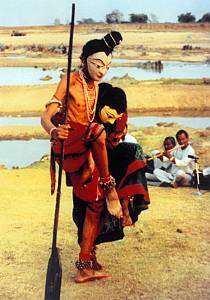March and April are festive seasons in India. It is also the harvesting season and songs and dances are part of rural harvesting festivities and rituals. New Year is celebrated in several Indian states in mid-April.
For example April is the peak season for Chau, inscribed in the Representative List of Heritage for Humanity. Purulia Chau dance groups who wear ornate costumes and masks had invested 1500-2000 USD in buying new costumes and masks for the season and will now have to face debt burden.
Charida village, the hub of mask makers which makes business of more than 1 million USD each season, are facing a crisis with lockdown. The dancers are worried that smaller groups will break up as dancers will have to probably migrate for work. All performing artists are facing loss of income owing to cancellation of festivals and cultural events.
Weavers and crafts are facing challenges of delivering orders and lack of raw materials. There is also apprehension about the cancellation of orders and less demand. All mentioned that their savings are dwindling and extension of lockdown will make day to day survival a challenge.
Agriculture and daily labour supplement income for many of the rural tradition bearers and the initial embargo that affected harvesting. While now the Government has relaxed restrictions for the unaffected districts, confusion remains. In very few states of India which have schemes linking artists to a banking scheme for the poor or stipends for artists, they have received INR 500-2000.
To ensure that the artists can maintain basic dignity of life, we mobilized cash donation directly to the accounts of the artists requesting financial assistance. The artists are getting free food grains from the Government.
With the onset of the COVID 19 pandemic, the country-wide lockdown in India, and the fear and uncertainty, we took the initiative to organize online events via our Facebook page MusiCal (@bncmusical) with folk singers and musicians of Rajasthan (66 folk singers and musicians) and Bengal (42). Among the artists from Rajasthan were Manganiyar, Langa and Mir musicians. Travel is an integral part of their livelihood. Most of them reside in remote villages of interiors of rural Rajasthan.
The artists from Bengal included both rural and urban singers (9). 39 programs have till date reached out to an audience of over 170,000. 108 artists have benefited.
The experience of doing the online event from their village was a new one for the folk singers. Some of the younger artists were excited to be able to perform online and reach out to hundreds of listeners even during these times of lockdown. For some of the elderly performers the virtual world and its nuances did not seem to have sunk in much; they were just happy that they were invited to perform, even if there was no real audience in front of them ! They were told that amidst the pandemic there will be people listening to them virtually. So they carefully chose their songs and raagas.
They sang about birth and life, about goodness and blessings; about loved ones who are waiting to return to each other, about calling the almighty who exists everywhere and is the world’s saviour.
They emphasized a feeling of being connected to other artists, singers, musicians and friends, both old and new, who have heard their programme and have called or written to applaud them and this gave positive energy to cope with present uncertainty and secluded life. The Gurus and masters expressed their joy of watching artists from rural interiors performing together with their family members, sons and even grandsons, who have learned to sing even before they learned to speak, as children.
Las designaciones utilizadas y la presentación de los textos y documentos presentados en esta plataforma no suponen ninguna toma de posición por parte de la UNESCO acerca de la condición jurídica de los países, territorios, ciudades o zonas ni respecto al trazado de sus fronteras o límites.
